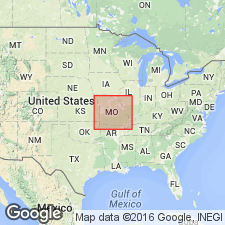
- Usage in publication:
-
- Cement City limestone bed*
- Modifications:
-
- Original reference
- Dominant lithology:
-
- Limestone
- AAPG geologic province:
-
- Forest City basin
Summary:
Pg. 27-28, 118. Cement City limestone bed of Chanute shale member of Kansas City formation. Present in northwestern Missouri and eastern Kansas. Thin but fairly persistent bed of gray, buff, or cream-colored limestone, 5 to 10 feet thick, lying 5 to 20 feet above base of Chanute shale member of Kansas City formation. Is believed to be Parkville limestone of Gallaher. At Kansas City it is known as "Gray ledge" or "Building ledge." Age is Late Pennsylvanian (Missouri age).
Named from Cement City, Jackson Co., northwestern MO.
Source: US geologic names lexicon (USGS Bull. 896, p. 386); GNC KS-NE Pennsylvanian Corr. Chart, sheet 1, Oct. 1936.
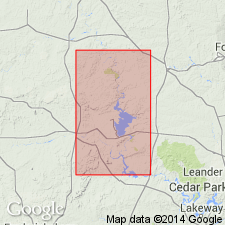
- Usage in publication:
-
- Cement City limestone member
- Modifications:
-
- Revised
Summary:
[See GNC remark (ca. 1930-1935) under Drum limestone.] Cement City limestone member of Drum limestone of Kansas City group. Divided Drum limestone into Corbin City limestone above and Cement City limestone below and this definition of Cement City limestone was followed by Moore and G.E. Condra in their Oct. 1932 revised classification chart of Pennsylvanian rocks of Kansas and Nebraska. Age is Late Pennsylvanian (Missouri age).
See also "Modern classifications of the Pennsylvanian rocks of eastern Kansas and southeastern Nebraska," compiled by M.G. Wilmarth, Secretary of Committee on Geologic Names, USGS unpub. corr. chart, Oct. 1936, sheet 2.
Source: US geologic names lexicon (USGS Bull. 896, p. 386).
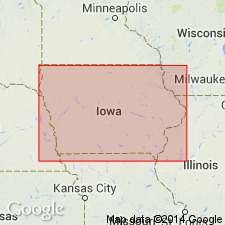
- Usage in publication:
-
- Cement City limestone
- Modifications:
-
- Overview
- AAPG geologic province:
-
- Forest City basin
Summary:
Pg. 11. Cement City limestone, according to Moore, is true Drum limestone at type locality.
Source: US geologic names lexicon (USGS Bull. 896, p. 386).
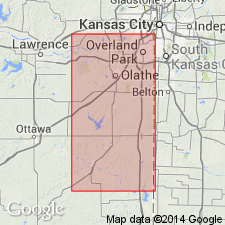
- Usage in publication:
-
- Cement City limestone member
- Modifications:
-
- Revised
- AAPG geologic province:
-
- Forest City basin
Summary:
Pg. 43+. Cement City limestone is basal part of true Drum limestone. This has been verified by R.C. Moore. The Chanute shale of Hinds and Greene included true Chanute, true Drum, and underlying Quivira shale of this report. The Quivira is top part of Cherryvalle shale. The Corbin City and Cement City limestone members of Drum limestone are unconformable. Age is Late Pennsylvanian (Missouri age).
Source: US geologic names lexicon (USGS Bull. 896, p. 386); GNC KS-NE Pennsylvanian Corr. Chart, sheet 2, Oct. 1936.
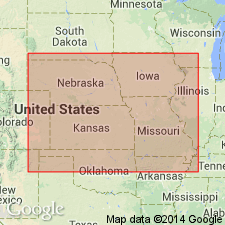
- Usage in publication:
-
- Cement City limestone member*
- Modifications:
-
- Overview
- AAPG geologic province:
-
- Forest City basin
Summary:
Pg. 2030, 2031 (fig. 4). Cement City limestone member of Drum limestone. Underlies Corbin City limestone member; overlies Quivira shale member of Cherryvale formation. Northeastward tracing proves that Dewey member of the Frum is the same as limestone called Cement City in Kansas City area. Dewey has priority over Cement City (Hinds and Greene, 1915) and is recognized as a formational unit by Oklahoma Geological Survey. Kansas Geological Survey has used Cement City for lower member of Drum limestone and Cement City was recognized by the interstate conference (May, 1947). Kansas proposes to deviate from the interstate classification by adopting Dewey instead of Cement City. Other State Surveys will continue to recognized Cement City until question of stratigraphic identity of the type of this unit (near Kansas City) and the Dewey is removed. Age is Late Pennsylvanian (Missourian).
Source: US geologic names lexicon (USGS Bull. 1200, p. 694-695).
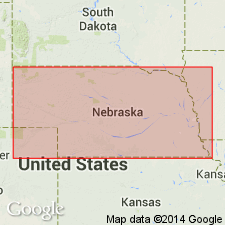
- Usage in publication:
-
- Cement City limestone member*
- Modifications:
-
- Areal extent
- AAPG geologic province:
-
- Forest City basin
- Salina basin
- Chautauqua platform
Summary:
Pg. 37. Cement City limestone member of Drum formation. Thickness near Winterset, southwestern Iowa, 6 feet; Sarpy County, southeastern Nebraska, 11 feet. Persists southward into Oklahoma. Age is Late Pennsylvanian (Missourian). Type locality stated.
Type locality: in cement plant quarry at Cement City [along Missouri River, northeast of Kansas City, Liberty 7.5-min quadrangle], Jackson Co., northwestern MO.
Source: US geologic names lexicon (USGS Bull. 1200, p. 694-695).
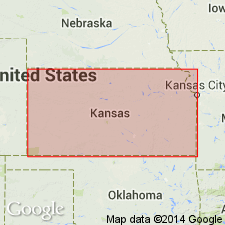
- Usage in publication:
-
- Cement City limestone member
- Modifications:
-
- Not used
- AAPG geologic province:
-
- Forest City basin
Summary:
(Paleozoic Era; Pennsylvanian System by J.M Jewett, H.G. O'Connor, and D.E. Zeller, p. 21-43.) Rocks of "Cement City limestone," locally recognized in Kansas City area, northeastern Kansas, are included in Dewey Limestone Member of Drum Limestone (Moore, 1948).
Source: Publication.

- Usage in publication:
-
- Cement City Limestone Member
- Modifications:
-
- Revised
- Reference
- AAPG geologic province:
-
- Forest City basin
Summary:
Pg. C393-C398; Appendix C, p. C62. Cement City Limestone Member of Dewey Formation of Linn subgroup [informal] of Kansas City Group. Includes oolitic facies previously assigned to overlying Corbin City Limestone Member (discarded). At reference section consists of (descending): (1) cross-bedded fossiliferous limestone with 3 to 6 inch thick beds of sand-sized fossil grains with micritic envelopes, 3.5 feet thick; (2) gray shale, 0.25 inch thick; and (3) thick-bedded tan limestone, 3 feet 10 inches thick. Total thickness 7+ feet. Overlies Quivira Shale Member of Dewey. Age is Late Pennsylvanian (Missourian).
Reference section: in west-facing embankment on Kansas City Southern RR, 200 ft south of abandoned crossing of the tracks on a now-closed east-west gravel road, 3 mi north of Cleveland, in NW/4 NW/4 SW/4 sec. 16, T. 45 N., R. 33 W., West Line 7.5-min quadrangle, Cass Co., MO.
[See entry under Drum Formation (Drum Limestone).]
["Subgroup" not recognized as a formal stratigraphic rank term (CSN, 1933; ACSN, 1961, 1970; NACSN, 1983, 2005, 2021). Considered informal and should not be capitalized.]
Source: Publication.
For more information, please contact Nancy Stamm, Geologic Names Committee Secretary.
Asterisk (*) indicates published by U.S. Geological Survey authors.
"No current usage" (†) implies that a name has been abandoned or has fallen into disuse. Former usage and, if known, replacement name given in parentheses ( ).
Slash (/) indicates name conflicts with nomenclatural guidelines (CSN, 1933; ACSN, 1961, 1970; NACSN, 1983, 2005, 2021). May be explained within brackets ([ ]).

